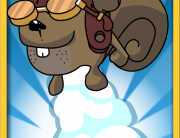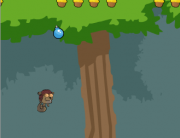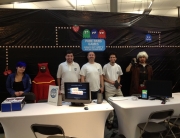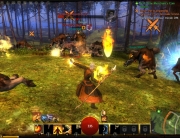Hi everyone! My name is Yuzun Kang, and I’m an associate producer and designer at Pure Bang Games. As part of my job, I play a lot of casual games to keep up with the casual game industry; and, yes, that means playing through a lot of bad games. But I’ve learned in the last two years that it’s very difficult to make games. So, I just appreciate the fact that the person or team responsible for the “bad” game had the conviction and commitment to complete and ship a game; and I always find one or two lessons and redeeming qualities to apply to our own games.
People, both inside and outside the game industry, think that making a casual game is easy. It can’t be that hard to create a repeatable 60 – 90 second experience, right? My old teacher, Charles Wright, once told me that the hardest thing to do is to be simple and emotional at the same time. What he meant was that simplicity and clarity often come at the expense of emotional complexity; and that to create something with clarity and simplicity without sacrificing complexity (whether it be emotional, thematic, or technical) is an elusive achievement for any artist.
One of the game companies I admire the most is PopCap, because they have been successfully mixing simplicity and complexity as long as I can remember. From Plants vs. Zombies, Peggle, and Bejeweled (has it really been 11 years since the first Bejeweled launch?), all their games are identifiable and iconic both in concept and execution.
I’d like to showcase their latest Facebook game, Solitaire Blitz, in the following months as part of a series on making casual games.
I recently tweeted about Solitaire Blitz, and likened it to “swimming in holy water.” Like all the great PopCap games, it rests on a perfect combination of opulent presentation, and austere and impeccable mechanics. The purity of the 60-second experience feels like a culmination of everything PopCap has perfected in terms of design, execution, polish, and feedback. Some of my friends think this game embodies a form of data driven corporate evil, but it would be a shame to let our personal prejudices to prevent us from playing exceptional games.
Creating, polishing, and balancing a short burst (60 to 90 seconds) casual experience is an act of faith, even when the hypothetical target values of “fun” are backed by user testing and experience. It’s like aiming for the other side of air. What’s so impressive about Solitaire Blitz is that it feels like the product of a team that no longer needs to take aim—they just know where the target is.
Moving the design aside for a moment, I would like to focus on a bird’s eye view of the game, and talk about the importance of concept and theme in creating a casual game. I think picking solitaire as a concept was a smart choice by PopCap. In concept and theme, Solitaire Blitz is an easy to understand concept for the casual gamer (it’s solitaire!) with an updated look and theme that is both playful, and a design that enforces strategy.
Most importantly, in a crowded market, people’s familiarity with solitaire allows PopCap to get their game out to as wide an audience as possible, even to those players who may be unfamiliar with who PopCap is. By picking this concept, they have made their jobs easier in terms of exposure and resonance.
The imperative behind the creation of any casual game, or any act of creation for that matter, is the need to be understood. A common mistake among junior designers is to delve immediately into the meat of the game, i.e. the game play (it’s a mistake I made when I first started two years ago). But the initial act of creating a game, and communicating your vision and experience, needs to be broader than that. A team should consider the concept, the theme, platform, architecture, and audience before the creation of any systems – these elements will define and drive the business and design decisions throughout the production process.
The concept (and accompanying theme) is the beginning and the connection between the player’s first encounter with the game’s thumbnail in an app store or a web portal, and the actual game experience.
Upon this first encounter, the potential player should be able to understand what the game is about, and what type of experience they can expect. If you’ve done your job, then the concept and the themed image will appeal enough to your potential target audience to merit a download.
More importantly, the concept image and the name you pick for your concept should resonate with the people you’re trying to get. Think of words and phrases that would conjure an experience that they’re seeking (hello, Dragon Age? If you like RPGs, you’re probably going to type the word dragon in at some point to look for a game. Or even hearing the word will get your attention, i.e. Dragon’s Dogma). That level of discoverability needs to be there for people to even find and encounter your game and accompanying thumbnail in an app store or web portal.
It’s a tough reality and a tough market—people looking for casual experiences on mobile and web don’t have the time or the patience to “explore” your concept. Their path to escapism has no room for investigation.
To put it bluntly, I, as the player, don’t have the time to figure out what your game is about; and even if I did, the barrage of daily apps and games that I am subjected to provides me with ample and well-executed alternatives that DO articulate their experiences (and whether those experiences are relevant to my interests) upon first encounter.
I know this sounds like cold market research. If you’re a one or two person team doing games on the side, then I think your ability to strike in any direction is less risky. However, when you have a full-time team like us, you have to consider whether the game is going to be worth the effort and potential rewards (whether it’s monetary or not) of going through the arduous process of creating a game.
Regardless of that, in order to justify the effort of making and completing any game, you should really find ways to get as many people to play your game as possible, and that means thinking about a concept and theme that would appeal to the people who would play your game. I mean if no one can find your game, or if you can’t convince anyone to play your game because of your poor app store and web portal presentation, then you have not completed the act of creating a game. Remember, someone has to play your game—that’s why you made it in the first place!
What I’m promoting here is that you should think about the games you would like to make. Then think about the people who will most likely play your game, and how to get in front of them. If you love RPGs, and you want to make an RPG, think about what players like you would want in terms of a resonant concept and theme. In addition, is this a concept and theme that will be easily discoverable by those people, and will it create an association of an experience that they want to download and participate in?
Next month, I’ll talk more about the design aspects of Solitaire Blitz. Thank you for reading. This was a tough article to condense into this short space, so feel free to ask any questions or leave any comments!






Leave A Comment